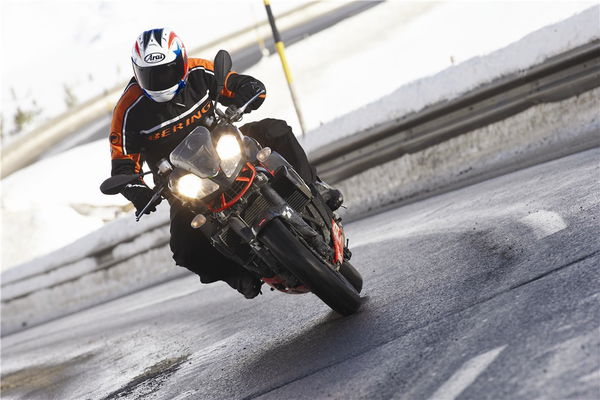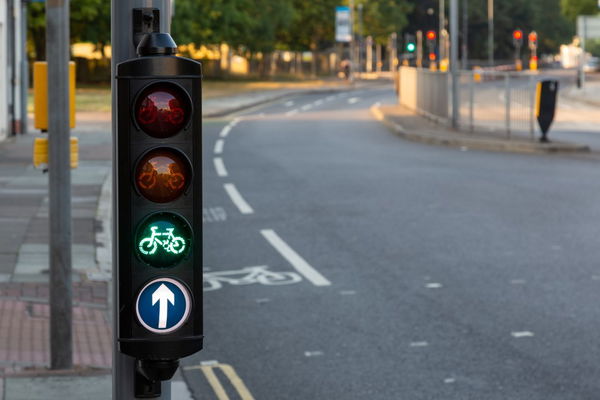Winter motorcycling tips
Face winter head-on with these tips for riding through to spring

IN THE Visordown office, we breathe a collective sigh of dismay as winter starts to bite. With short days, low temperatures, wet, greasy, salt-ridden roads and poor visibility, it’s not a season that’s particularly kind to us but that doesn’t mean we have to stop riding once conditions become a bit trickier.
While some riders tuck their bikes away at this time of year, for some, riding through the winter is a fact of life and if like us, you’ve got no intention of giving up your enjoyment of riding at this time of year, here are some tips for facing old man winter head on (and kicking him in the nuts).
1. Keep warm
Obvious, hey? This almost goes without saying but without decent winter kit, you're doomed. If you’re cold, wet and suffering from numb hands and a cold core, you’ll be distracted, your reaction times will suffer and you’ll risk not being in proper control of your bike.
Buy the best kit you can afford and ditch the leathers – textile jackets and trousers will be most effective at keeping you dry and insulated. You want something with a thick, warm lining and look out for any technical materials that could fend off rain and road spray – a Gore-Tex membrane is always a good bet.
It’s the same story with boots and gloves – you want waterproof boots and gloves with a warm, thick lining that’ll keep your hands insulted against the wind and rain. It’s critical you keep your hands well protected from the cold because once you get numb fingers, your fine motor skill suffers and coming off the motorway with little feel for how much pressure you’re putting through the front brake lever is never a nice feeling. If you’re off on a long journey, carry a spare pair of gloves with you.
Base layers will help keep you warm under your clothes and jacket/trousers. Merino base layers are comfortable and good at trapping heat, and there are plenty of windproof leggings and long-sleeved tops out there that’ll give you an extra layer of defence against the chill in the air.
If you really want to stay toasty this winter, it worth investing in a heated vest, like this one from Keis. Honestly, get one of these and you’ll wonder how you survived without one.
It's pretty basic stuff really: the more you ride your bike, the better you'll get. There's a theory (from renowned brainbox and intellectual geek Malcolm Gladwell) that you need to practice a skill for 10,000 hours to become an expert. Gladwell looked at people like Bill Gates, who spent 10k hours on computers before he started up Microsoft. The theory's been criticised, but even the hardest critics accept it has some effect in 'sports'. Riding a bike is a mental/physical skill, so is closer to a 'sport', even if you're not competing. So, every hour spent on the cold, wet A47 is making you better at riding, even if it doesn't feel like it…
DURING winter you’ll be up against less hours of daylight, increased cloud cover and visibility problems caused by mist, fog and rain, so it’s more important than ever to make sure you’re visible.
Car drivers will have their own problems with visibility too, thanks to misted up windows and when it gets really cold, there are plenty of dickheads out there who can only be bothered to scrape just enough ice/snow off their windscreens to see straight ahead, let alone see you.
Increase your visibility by investing in some winter riding kit that’s not completely black – jackets with fluorescent and reflective panels will help mark you out.
To help maximize your chances of being seen, hi-viz is the way to go and if you’re deeply averse to donning a flouro jacket and helmet on the grounds that it’ll make you look uncool, winter is the time to accept that the benefit provided is probably worth it (and anyway, no one thinks you’re cool).
Your road positioning can also help when it comes to seeing and being seen so don’t sit too close the vehicle in front of you, instead position yourself so your front light can be easily noticed by the driver in front, don’t ride in the gutter, position yourself so that you can see through corners and use the space available in your lane to your advantage – moving around will make you more noticeable, give you better visibility and will signal your intentions to other road users.
Finally, if you’re the kind of rider who religiously uses a tinted visor, try using a clear one, or at least carry one with you. Get a pinlock insert too – they’re a godsend in winter and will prevent your visor fogging up thanks to your cold breath and the rain/moisture outside.
WITH GREASEY, wet roads, reduced visibility and the risk of ice during winter, riding smoothly, taking your time and planning ahead becomes even more important.
That means being progressive and gentle when it comes to applying power and getting on the brakes. Even on bikes with ABS and traction control, you want to avoid jabbing at the brakes giving it a handful of whiskey throttle.
Slow. Things. Down. And be patient. Leave yourself more room to think and react – dropping back from the car in front will give you a few more precious seconds on a cold, slippery surface.
Think about the road ahead – there could be debris, puddles or potholes in the way and you want to give yourself enough time to find a safe way past them.
A SET OF sticky fast road/track rubber might be just the thing for a sunny Sunday morning blast in July, but they won’t cut it in winter because they’ll have little chance of properly warming up and won’t perform at their best when it’s cold and wet.
For winter, fit some dedicated road tyres that’ll work in a wide range of conditions, heat up and provide trustworthy grip.
Sports touring rubber like Metzeler Roadtec 01s, Michelin Pilot Roads or Pirelli Angel GTs are all a safe bet and should provide consistent performance and longevity during the winter.
Once you’ve got the right rubber fitted, be sure to regularly check your pressures are correct.
British track days might sound like a dead-end in winter – but they still go on. And best of all, they are really cheap. So you can afford to lose the odd one or two to snow, ice and plagues of frogs. If you're prepared for the cold and wet, you can still make big steps forward in your riding. Get an older, cheaper track bike (not like those pictured), load it up with crash protection, and shell out for a set of spare wheels with wet-weather tyres on. With a rainproof oversuit over your leathers and some thermals underneath, you'll be snug (ish), while you learn more and more about grip, traction, braking, body positioning, weight transfer and track positioning.
WINTER isn’t just hard on you, it’s tough on your bike too, so it’s important to ensure it's in top condition.
Begin your winter bike prep with a service; it’ll highlight anything that needs attention and will give you some assurance that you’ve got the right fluid levels/grades and that everything’s correctly adjusted.
Winter is hard on batteries, so make sure you keep an eye on the health of yours. Check it’s holding a charge and delivering enough power when the bike is running. Charge it if required. Consider hooking it up to a trickle charger to keep it topped up. Lastly, applying some silicone grease to the terminal will ensure that air and water are kept out.
Check your headlight(s), indicators and rear lights are working properly and check their connections. Greasing connections will help prevent water ingress and corrosion built up.
Keep your chain in good condition with regular cleaning and lubing. A Scottoiler could come in useful here.
Applying a bit of grease in key areas will also help keep things moving freely and help prevent corrosion. A good place to start is by removing levers, cleaning them, applying some grease and refitting. The same goes for cables and exposed threads and any screws / nut heads you want to keep protected.
The biggest enemy to your bike in winter is the risk of corrosion from salt. You either need to give your bike a blast with the hose a few times a week (though every day would be best) or use a corrosion protector spray like ACF-50’s Anti-Corrosion Formula, Muc-Off Motorcycle Protectant or Scottoiler FS 365 Corrosion Protector. They all work by leaving a protetive layer on your bike, so filthy, salty water can’t get through to the metal. You’ll need to reapply periodically and ensure you wash it all off come the spring.
Riding off-road often means getting wet, even in the middle of summer… So why stop just for winter? And if you don’t work up a sweat despite the cold, you’re no trying hard enough.
By getting into green-laning, you can easily keep riding in the dirt when the weather turns. We regularly speak about how riding in the dirt can sharpen your road skills, and it actually gets better in the wet. Dealing with a loss of grip at front and rear, modulating throttle and brake inputs when the tyres are spinning – these are all super-advanced skills on the tarmac, but commonplace stuff in the mud. And regularly heaving a 250kg adventure bike out of big puddles is one way to stay warm.
Click here for more Visordown riding tips.
- A version of this article was published in November 2016.











